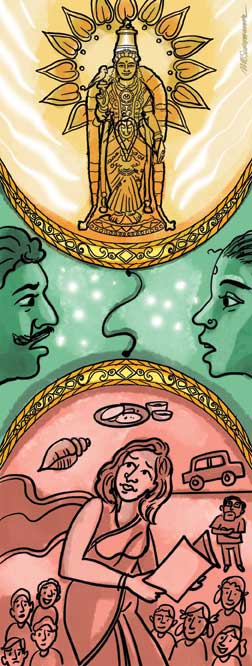Devika Nadig
The journey of a thousand miles began with the launch of Shikshangan in 2008 and continued much beyond this distance by covering the length, breadth and depth of our country. In the course of these journeys and the many interactions they brought, Vijay and I learned from individuals, communities and multiple stakeholders in the education landscape. I reckoned it would make sense to share these experiences with a wider audience with the aim of documentation and a hope that these will both entertain and educate. Each tour was unique and I hope my storytelling skills will amuse and not lose – readers.
In this first installment in the series of travelogues-cum-dialogues (hence Edulogues), I begin by dipping into the memories of our travels through cities and towns which inadvertently put me dangerously close to a famed deity. Dangerous, because as a mildly practicing Hindu, being so close and not paying obeisance would be questioned – if by no one else at least by my own conscience which was ticking with a steady, sonorous beat.
First stop – Meenakshi and Rameshwaram
An old acquaintance from our days at Wipro Applying Thought in Schools, Prema Narsimhan, wrote us an email asking us to hop on to a flight to Chennai, take an overnight train to Madurai, where she had a vehicle waiting for us at the railway station to drive us smoothly into the city of Madurai which was burning at 45 degrees! A quick shower and change and we were ready in a comfortable air-conditioned hotel room, waiting to be escorted to the TVS Office.

Excited as I was to be in the heart of Tamil Nadu, there was also an eagerness to meet and interact with the daughter of an automobile industry baron who runs a chain of schools. Draped in a pastel saree with Vijay in a comfortable T shirt, we were sipping our post breakfast coffee as Prema breezed into our room.

We were meeting after five years and I was predictably carrying Pune’s famous Chitale Mithai for her. As our gaze met, her face fell. From surprise it went quickly to remorse and she stuttered and stammered for words. I gave her a quick hug, thinking she needs to break the ice. There was none in my mind! What she said next stumped me. Hesitatingly she said, “Devika, here they do not allow women to wear sleeveless clothes. Least of all the kind of choli you are wearing.” I froze. I thought covering the syllabus would be more in focus than covering my shoulders!
It was my turn to look desolate. My carefully planned summer wardrobe now had to be thrown to the winds, and my fiercely liberal views were under attack. I stole a glance at Vijay who had typically busied himself elsewhere. Left with no choice I said, “I do not have anything with sleeves packed for this trip Prema, because I expected a different kind of heat here.” This kind of won the day, but all along the drive to the school I had to listen to doubts about how I might not be allowed inside the famous Madurai Meenakshi temple and how I could meet the top boss in office in this attire and so on. The trusty pallu came to my rescue and I met the genteel lady boss looking like a Maharani of Rajasthan embracing Tamil Nadu – with pearls around my neck and a fashionable but modest covering around my shoulders.
None of this discomfort and mismatch of cultural moorings came in the way of our two-day coaching session with the teachers and our module on Effective Teaching Strategies did not fail to impress. Based on cutting-edge pedagogical practices, we introduced the teachers to new ways of looking at the purpose of homework, consolidation of and reflection on learning, note taking as a powerful learning tool, use of graphic organizers for webbing of concepts, and the idea of autonomy in the classroom.
I look back fondly at several photographs captured then, in the pre-smartphone era and it makes me smile when I recall the controversy around my attire.
Worthy of note is that our trip to the absolutely stunning Meenakshi Madurai Temples was effortless in this demure drape, with me breezing through the temple ‘Dwarpals’ as a dignitary would, and I was gifted a tiny left facing conch shell by the priest, telling me that this shell, if kept in my prayer room would bring me back to the shrine. I dutifully placed it where recommended, but the next visit hasn’t happened in the decade since.
You cannot come away from Madurai without gorging on the famous Madurai Murugan Idli and the cold seaweed drink to douse the heat. Picking up a couple of Sungudi sarees, I swore I would do better with cottons on the next trip.
Checking out of the hotel, we changed into a casual wear and headed for Rameshwaram – the holiest of holy shrines – one out of the twelve Jyotirlingas sacred to the Hindus. The sea beckoned and I found myself offering prayers for the wellbeing of family. I recall walking along the shores and this time, purchasing a rather large conch shell, which still sits in my Devhara (prayer space) at home. Over the years I have become adept at blowing on it to keep my lungs healthy, with more intensity now with Covid lurking around the corner.
(Illustrations by M B Suresh Kumar)
The author has been engaged in the domain of school education for the past three decades. She is the co-founder of Shikshangan Education Initiatives, Pune, along with Vijay Gupta.The scope of their work includes teacher development by sharpening pedagogical skills and working with school leaders on their instructional and organizational leadership skills. She can be reached at devika@shikshangan.org.
